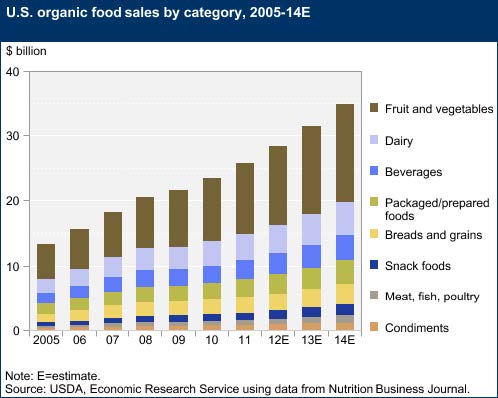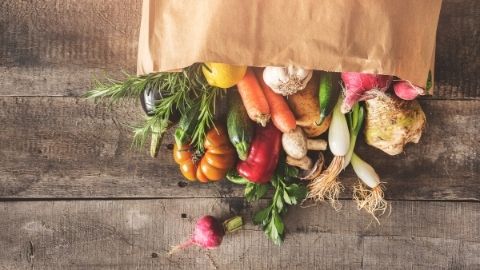Does Consumer Knowledge of Organic Production Standards Influence Demand for Organic and Non-GMO Labeled Foods?
Introduction
Sales of organic food products increased significantly over the past several decades, increasing from $3.4 billion in 1997 to $45.2 billion in 2017 (Organic Trade Association, 2018). Sales in the “organic breads and grains category” has grown steadily since 2005 and was the fifth largest category of organic products sold by 2014 (ERS, 2014). One of the requirements for food labeled “organic” is that the product must be produced using non-GMO ingredients (NOP, 2002). There are products with “non-GMO” labels available in the marketplace as well, and similar to organic, their sales have been increasing (from $12.9 billion in 2012 to $21.1 billion in 2016 (USA Today, 2016)).
There is currently some concern that the availability of non-GMO labeled foods may hurt organic food sales, as consumers become increasingly concerned about GMOs and some lack knowledge that non-GMO is one of the features of organic foods (Roseboro, 2015). Thus, a better understanding of how consumers view and value these two labels is needed. In particular, it is important to understand whether combining the organic and non-GMO labels on food products would be helpful or not, and if their actual consumer knowledge of organic standards makes an impact. This fact sheet summarizes a study conducted on consumer willingness to pay (WTP) for organic and non-GMO labels alone and in combination for bread and cookies, and how consumer knowledge that organic is non-GMO and overall organic knowledge of organic standards impacts WTP.

Data Overview
The data used for this fact sheet comes from a consumer survey with 1,009 respondents in the U.S. West, conducted online in the summer of 2017. Respondents were asked questions about their shopping and organic consumption habits, lifestyle, preferences for wheat products, reasons for purchasing or not purchasing organic products, general attitudes towards organic foods, knowledge of organic production, and general sociodemographic questions. Additionally, respondents were provided with eight purchasing scenarios where they were given an organic product, a nonorganic product, and a no purchase option to choose from. The pricing and product labels present on each product was randomized such that they were different across the eight choices. Their responses allowed us to estimate how much they would pay for break and cookie products with one label or a combination of labels.
Role of Organic Knowledge
Table 1 summarizes respondents’ overall knowledge of organic standards and how many knew specifically that organic is also non-GMO. Consumer knowledge was determined by asking respondents if six statements about organic standards and production methods were true or false. One of these statements mentioned that organic production allows for the use of GMOs. Nearly 84% of respondents identified correctly three statements or less, which means that overall, consumers do not have a good understanding of what organic really is. Close to 40% of the respondents knew specifically that non-GMO is one of the features of organic. As consumer overall knowledge of organic standards increases, they are more likely to know that organic is also non-GMO.
| Table 1: Respondent Organic Knowledge | ||
|---|---|---|
| Count | Share | |
| Low knowledge (0-1*) Organic is non-GMO |
356 30 |
35% 8%a |
| Medium knowledge (2-3*) Organic is non-GMO |
490 245 |
49% 50%a |
| High knowledge (4-6*) Organic is non-GMO |
163 128 |
16% 79%a |
| Whole sample Organic is non-GMO |
1,009 403 |
100% 40% |
Notes: *Number of correct answers. aShare of respondents within a knowledge group.
Knowledge that Organic is Non-GMO: Impact on WTP for Organic and Non-GMO Labels
 Table 2 summarizes the WTP values for the organic and non-GMO labeled bread and cookies, separately and combined, for the whole sample. Standard deviation illustrates how far the values are spread away from the mean. Shares of consumers with WTP > $0, $1, $2 are reported as well. On average, consumers are WTP similar amounts for organic and non-GMO labels on bread, but they are WTP more for the non-GMO label on cookies. Further, consumers value organic and non-GMO labels more on bread than cookies. This could be because bread is a staple, every-day food item, and people may be more concerned about safety of items they consume more frequently. Also, the healthy image of the organic label may be in conflict with expected taste and so it may be overall less desirable in hedonistic food items such as cookies. Finally, a higher share of consumers were WTP more for the non-GMO label than the organic label, but those who are WTP extra for organic are WTP higher amounts.
Table 2 summarizes the WTP values for the organic and non-GMO labeled bread and cookies, separately and combined, for the whole sample. Standard deviation illustrates how far the values are spread away from the mean. Shares of consumers with WTP > $0, $1, $2 are reported as well. On average, consumers are WTP similar amounts for organic and non-GMO labels on bread, but they are WTP more for the non-GMO label on cookies. Further, consumers value organic and non-GMO labels more on bread than cookies. This could be because bread is a staple, every-day food item, and people may be more concerned about safety of items they consume more frequently. Also, the healthy image of the organic label may be in conflict with expected taste and so it may be overall less desirable in hedonistic food items such as cookies. Finally, a higher share of consumers were WTP more for the non-GMO label than the organic label, but those who are WTP extra for organic are WTP higher amounts.
For bread, knowledge that organic should be non- GMO brings mean WTP for the combination of the organic and non-GMO labels above mean WTP for the organic label alone (see Table 2). For cookies, the combination of organic and non-GMO labels yields higher mean WTP than for organic label alone, regardless of the consumer knowledge that organic must also be non-GMO.
Overall Organic Knowledge: Impact on WTP for Organic and Non-GMO Labels
Table 3 reports mean WTP values for the two labels alone and in combination, estimated separately for consumers with low, medium, and high knowledge of organic standards. For bread, those with high organic knowledge are WTP the most for organic and non-GMO labels alone and combined. Those with low organic knowledge are WTP the least for the labels alone and they require a discount if both labels are present—for them, the label combination is confusing. Also, they are WTP more for the non- GMO labeled product than the organic version. Those with medium knowledge are WTP more for the combination of labels than for the organic alone, but only if they know that organic is non-GMO. For cookies, only consumers with medium knowledge of organic are WTP extra for the labels alone and combined. However, within all groups there are consumers with positive and negative WTP for the labels alone and combined, since the standard deviations are non-zero (not reported).
| Table 2: WTP Values for Organic and Non-GMO Labels | ||||||
|---|---|---|---|---|---|---|
| Product | Labels | WTP Mean | WTP St. Dev | WTP>$0 | WTP>$1 | WTP>$2 |
| Bread | Organic only Non-GMO only Both labels* Both labels** |
$0.54 $0.56 $0.34 $0.75 |
$2.49 $0.64 $2.67 $2.67 |
59% 81% 55% 61% |
43% 25% 40% 46% |
28% 1% 27% 32% |
| Cookies | Organic only Non-GMO only Both labels* Both labels** |
$0.00 $0.17 $0.17 $0.17 |
$2.07 $0.63 $2.16 $2.16 |
50% 61% 53% 53% |
31% 9% 35% 35% |
17% 0% 20% 20% |
Notes: *Total WTP for the combination of organic and non-GMO labels without knowledge that organic is non-GMO.
**Total WTP for the combination of organic and non-GMO labels with knowledge that organic is non-GMO.
| Table 3: Impact of Overall Organic Knowledge on Mean WTP | ||||
|---|---|---|---|---|
| Product | Label | Low knowledge | Medium knowledge | High knowledge |
| Bread | Organic only Non-GMO only Both labels* Both labels** |
$0.00 $0.35 -$0.13 -$0.13 |
$0.91 $0.70 $0.66 $1.13 |
$1.28 $0.74 $2.03 $2.03 |
| Cookies | Organic only Non-GMO only Both labels* Both labels** |
$0.00 $0.00 $0.00 $0.00 |
$0.41 $0.34 $0.75 $0.75 |
$0.00 $0.00 $0.00 $0.00 |
Notes: *Total WTP for the combination of organic and non-GMO labels without knowledge that organic is non-GMO.
**Total WTP for the combination of organic and non-GMO labels with knowledge that organic is non-GMO.
Conclusions
 Results show that consumers vary in their WTP for organic and non-GMO labels separately and in combination, and their knowledge of organic production standards does make a difference.
Results show that consumers vary in their WTP for organic and non-GMO labels separately and in combination, and their knowledge of organic production standards does make a difference.
Many consumers do not have a clear understanding of what organic really is and its relation to the non- GMO label. Specifically, those with low knowledge of organic standards are the ones who would pay more for the non-GMO labeled product. Those with high organic knowledge are WTP more for products with both labels, than just the organic label alone. Thus, some consumers find the combination of the organic and non-GMO labels useful, while others find it confusing.
These results suggest that educating consumers about organic standards and production systems may likely increase consumer interest in and WTP for organic food, as well as allow them to make more informed choices with respect to organic and non-GMO labels. Finally, large differences in WTP values found between bread and cookies are likely driven by the differences in consumption frequency and hedonistic characteristics of cookies, but they also illustrate how important it is that food manufacturers and marketers examine the market potential for a specific product.
References
- Organic Trade Association (OTA). 2018. “Maturing U.S. Organic Sector Sees Steady Growth of 6.4 Percent in 2017.” Press release. Available at: https://ota.com/news/press-releases/20236.
- Roseboro, K. 2015. “Is Non-GMO Hurting Organic?” Available at: http://non-gmoreport.com/articles/march-2015/is-non-gmo-hurting-organic.php.
- USA Today. 2016. “Non-GMO Demand Growing Despite Report that Says GMOs are Safe.” Available at: https://www.usatoday.com/story/money/2016/05/18/gmo-report-not-likely-to-change-minds-over-gmo-concern/84501686/.
- U.S. Department of Agriculture, Economics Research Service (USDA-ERS). 2014. Organic Agriculture Overview. Available at: https://www.ers.usda.gov/topics/natural-resources-environment/organic-agriculture/.
Authors
Tatiana Drugova, Post-Doctoral Fellow, Department of Applied Economics; Kynda R. Curtis, Professor and Extension Specialist, Department of Applied Economics
Related Research














